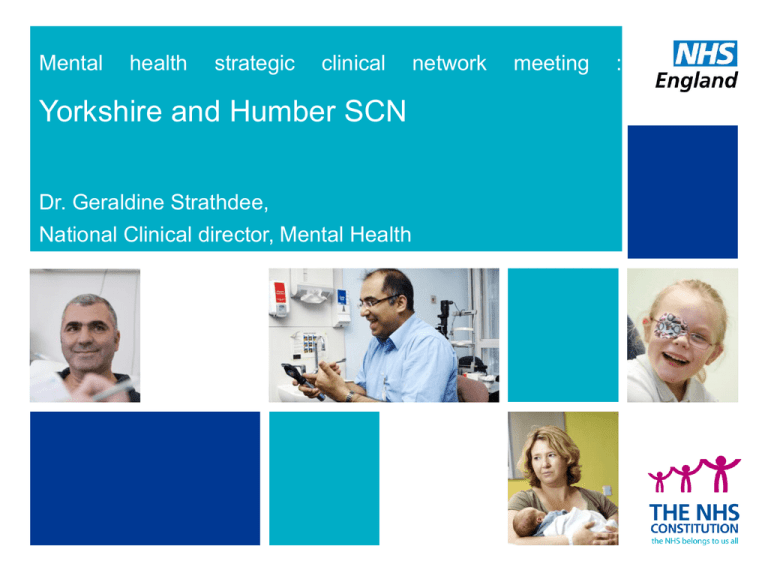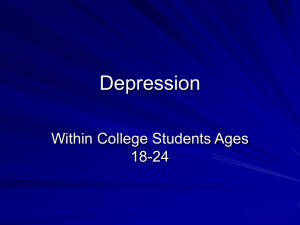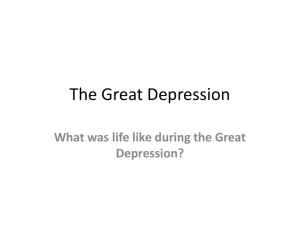Presentation heading - Mental Health Partnerships
advertisement

Mental health strategic clinical Yorkshire and Humber SCN Dr. Geraldine Strathdee, National Clinical director, Mental Health network meeting : Today’s discussion • How common is mental ill health • What are we trying to achieve • What are the priorities • No health without mental health’ national strategy • NHS Mandate • Emerging SCN priorities across the country • Progress update • How can we help and what can we learn from Y&H • We need your leadership, your expertise and your drive! 2 NHS | Presentation to [XXXX Company] | [Type Date] How common is mental ill health 3 NHS | Presentation to [XXXX Company] | [Type Date] How common are mental health conditions Our children 1 in 5 under the age of 15 Only 25% can access care 50% bullied, leading to: •Depression •Low selfesteem •Suicide 1: 10 have unrecognised dyslexia, dyspraxia The workforce Senior citizens All communities 1 in 6 adults at any time Dementia effects •5% over 65’s 1020% over 80 Over 300 spoken languages in UK; many cultural beliefs & mental health issues 1: 10 have depression Suicide is the greatest cause of male deaths < 35 yrs Work related stress affects 1.5 million 5.6 million work days lost a year 1 in 6 over 65 suffer from depression Major factors: •Social isolation •Physical illhealth 30% of >65s in Acute Trust beds have dementia Overrepresentation of black people in acute inpatient & forensic care The prevalence of mental health & impact on outcomes Prevalence ICD conditions Outcome impact Primary care : 30-50% of daily workload Acute care 20%-40% of A/E in 40% acute beds 50% acute LTC outpatient clinics Prisons & offenders 70-80% especially young men Specialist mental heath services Depression & anxiety Substance misuse Children's conditions Premature mortality : 15-25 years Quality of life in LTCs Recovery from illness Patient safety Patient experience Alcohol & drugs Depression & self harm Depression Dementia Premature Mortality Quality of life for LTCs Recovery from illness Patient safety Patient experience ADHD, ASD Depression Substance misuse PD Premature Mortality Psychosis Neurodevelopmental Substance misuse Personality disorders Complex multi axial Premature Mortality : 15-25 years Quality of life in LTCs Recovery from illness Patient safety Patient experience Depression : think about the causes & solutions follow.. opportunities for demand management, prevention & early intervention across Value care pathways Elderly isolated & people with dementia Isolated women with small children People with schizophrenia and sight and hearing problems Victims of domestic violence Dyslexia, Dysprexia ADHD, Autism, Asperger’s and Learning Disabilities Victims of school and employment stress and bullying Key life cycle: •Divorce •Retirement •Redundancy •Menopause Long term physically ill Alcohol and drug addictions 3. The top 10% of Mental health conditions: service redesign for prevention, earlier identification better access & treatment for young The origins and causes of mental ill&health eople The life span health & social determinants of mental health conditions Genetic & biochemical Organic brain & neurodevelopmental Societal • Life span high risk events •Long term physical conditions •Unemployment •Adolescence •Pregnancy •Bereavement •Migration •Gang/ veteran trauma Biochemical ‘causes’ Caffeine, nicotine, alcohol, street drugs Neurotransmitters Endocrine disorders Family history Substance misuse /mental ill health/ chaotic deprivation / abuse: physical, sexual, emotional School difficult Dyslexia, Dyspraxia, ADHD, Autistic spectrum, Bullied ‘What could we do?’ Truanting Drug use & dealing Petty crime In Care Mental illness starts Regarded as ‘bad’ or ‘strange’ ‘What should we do?’ Institutions career Expensive placements Youth offenders Acute psychiatric wards Forensic units ‘How should we do it?’ What Outcomes do our service users ask us to support them achieve What Outcomes do our patients ask us to achieve in partnership with them Safety “Will I be ok?” From the patient’s perspective Effectiveness “Will it do me any good?” Experience Efficiency Was it fast, safe , near home , back to work asap “Access, information & treatment experience” Least restrictive settings Professor Bruce Keogh, Medical Director of the NHS Parity : NHS Mandate: what does it mean in practice • I was struck the other day when I saw a patient - who has been off work for From a London GP ………………… 3 months waiting for CBT. He is depressed and was just told to go on sick leave- no medication, just a referral for CBT in the distant future. • When I saw him , what upset me most was that if he had broken his leg, he would have been treated asap, given rehab, told to go to work on crutches and would not have just been abandoned. • I want to make it impossible for mental health problems to be treated as second class illnesses - with patients with treatable conditions languishing on waiting lists or worst still with no treatment at all Clare Gerrada GPs are trying to do everything for everyone, too much of 21st Century care is being provided through 19th century organisational models……… Professor Michael Porter is a world authority on strategy in business, & has spent the past decade working in healthcare systems in dozens of countries. The economic impact: 2012 Figure 1: Morbidity among people under age 65 Physical illness (e.g. heart, lung, musculoskeletal, diabetes) Mental illness (mainly depression, anxiety disorders, and child disorders) successful outcome. The second point is the level of cost-effectiveness as measured by cost per QALY. This involves two further factors. First there is the severity of the condition which is averted, and second the cost per case treated. The concept of severity used by NICE is that each medical condition involves a reduction in the quality of life, and a successful treatment thus increases the number of Quality Adjusted Life Years (QALYs). The cost per QALY is then the (inverse) measure of the cost-effectiveness of the treatment. The informal cut-off Mental health has among the most clinically and cost effective treatments of any sector but access is low and a post code lottery 22 Annex B: Prevalence of adult mental health conditions and % in treatment, England 2007 % of adults diagnosable (1) % of (1) in treatment (2) % of (1) receiving counselling or therapy 15.0 24 10 PTSD 3.0 28 10 Psychosis 0.4 80 43 Personality Disorder* 0.7 34 ADHD 0.6 25 4 Eating disorders 1.6 23 15 Alcohol dependence 5.9 14 6 Drug dependence 3.4 Anxiety and/or depression Cannabis only 2.5 14 7 Other 0.9 36 22 Any condition 23.0 * Includes Anti-social P.D. and Borderline P.D. Note: The conditions are not mutually exclusive. 18 Table 5: Cost-effectiveness of some treatments for mental and physical illnesses Mental illness Depression Social anxiety disorder Post-natal depression Obsessive-Compulsive Disorder Physical illness Diabetes Asthma COPD Cardio-vascular Epilepsy Arthritis Treatment Numbers Needed to Treat Cost per additional QALY CBT v Placebo CBT v Treatment As Usual (TAU) Interpersonal therapy v TAU CBT v TAU 2 2 5 3 £6,700 £9,600 £4,500 £21,000 Metformin v Insulin Beta-agonists + Steroids v Steroids Ditto Statins v Placebo Topirimate v Placebo Cox-2 inhibitors v Placebo 14 73 17 95 3 5 £6,000 £11,600 £41,700 £14,000 £900 £30,000 What are the priorities & progress • No health without mental health’ national strategy • NHS Mandate & Suicide prevention strategy • Emerging SCN priorities across the country • AHSNs • LETBs • New funding streams Emerging System priorities ..a system based on value, equalities & shared learning 1. CCG: building capacity and capability in mental health leadership 2. Primary care mental health 3. Care of people with psychosis : ‘industrializing’ improvement 4. The acute care pathway and suicide prevention 5. Integrated physical & mental health care pathways 6. Mental health intelligence informatics network programme • new model of information led commissioning & integrated provision • Whole pathway commissioning of Tiers 1-4 Underpinning Value based commissioning and care • Outcome measurement • Service specifications aligned to PbR and Choice • Reducing burden to free up time to care CCG GP Mental health leadership programme Knowledge based leadership for high impact and improving outcomes ….……a new model of leadership Personal leadership development Mental health Informatics competency Expert ‘what good looks like’ immersion week Commissioning Information and best practice The national care pathways priorities What do we want to commission with partners Prevention & health promotion Early identification & early intervention Timely Access to services offering choice, quality outcome focus Care at home or in the least restrictive settings, Crisis response that is easy to access & expert Parity for people with physical & mental health Integrated physical & mental health & social care Where every contact is a kind enabling, coaching experience Step 1: Information for Commissioning value based care pathways we have commissioned unique whole care pathway health & social care information for every CCG In this CCG/ borough, what are the social determinants of mental ill health How common are mental health conditions in this area What are the high risk groups to target for risk stratification and prevention What % age of people with these conditions are GP QOF identified ( and coded) What funding is spent on mental health in primary care, social care and specialist mental health hospital beds & community services What evidence based services are available in this borough Are standards of services meeting NICE NCB, QOF, COF, CQC, Monitor, Outcomes domains, Operating framework, PbR What are the key high risk prevention & top 10% QIPP opportunities Clinical and economic best commissioning tools What are the top 4 service ‘Best buys’ Model service specification examples Economic modelling tools to design and reengineer effective models for local needs The evaluation and shared learning indicators CCG MH shared learning & provision network Expert clinical reviewers & implementers 2. Primary mental health care in England internationally: GP roles clinicianaround the many roles of they are usingIndividual systems thinking GPs Primary care multi disciplinary team Leadership & organization of the practice GP as community leader & prevention GP as Commissioner International learning : Primary care mental health service organization: a ‘stratification’ approach & federated models e.g. ‘ (Kaeser, Scandanavia, US Vets Primary care service organization Demand management : reduce employment and school and community causes Prevention targeting of High risk groups Self assessment & self management Mild Common conditions Moderate primary care repeat attenders & LTCs Long term severe mental illness An example of a federated model Hungary Depression & suicide reduction Training, systems redesign, whole team sustainable approach Szanto et al ( 2007 Training for 28 GPs serving 73,000 people. 5 year Depression-management educational program for GPs In addition to training individuals, services were reorganised and expertise commissioned to support primary care in a sustainable way. Practice nurses were also trained A Depression Treatment Clinic & psychiatrist telephone consultation service was established. Conclusion: GP-based intervention produced a greater decline in suicide rates cf with the county & national rates.. Key conclusion was that additional service reorganisation such as depression case managers should be tried. The importance of alcoholism in local suicide was unanticipated and not addressed Shared whole pathway learning GP Master class series Oxleas NHS Foundation Trust runs a series of free evening masterclasses on mental health and learning disability issues for primary care professionals. The aim of the series is to: • Provide GPs with updates on the current evidence-based treatments for common mental health conditions • Share information on new assessment tools • Share best practice care pathways • Topics have included depression, dementia & child & adolescent mental health issues. AHSNs working with SCNs and LETbs UCLP practice nurse master classes • 2. 5 hour Masterclass for practice nurses • Masterclass developed by a practice nurse mental health expert with RMNs • Train the trainer model : 1 specialist MH nurse trainer per CCG • 2.5 hour master classes in each `CCG area for 20 PNs • 800/1400 London practice nurses trained in 6 months • New modules in depression, suicide prevention, planned 23 NHS | Presentation to [XXXX Company] | [Type Date] Acute and unplanned care emerging thinking Admissions to Acute Care in acute mental health beds £ Emergency Department Mental health liaison team £ ( dementia, alcohol, psychosis, self harm all ages ) £ Intermediate tier Single Crisis number coordinating tele triage, tele health + 24/7 community Home treatment team & community alcohol detox, £ £ £ Primary Care & self- care 5. Integrated physical and mental health care Long term conditions Mental health raises costs in all sectors Chris Naylor, Kings fund • Overall, international research finds 180% that co-morbid MH problems are increase in service costs per patient (after controlling for severity of physical illness) • Between 12% and 18% of all expenditure on long-term conditions is linked to poor mental health and wellbeing – at least £1 in every £8 spent on long-term conditions. % increase in annual per patient costs (excluding costs of MH care) associated with a 45-75% 160% 140% 120% 100% 80% Depression Anxiety 60% 40% 20% 0% Co-morbidity is the norm Lancet, Barnett, Mercer et al 20 2012 publication Compendium of examples of cost effective programmes for people with physical illnesses in acute trust, primary care settings The Ian Galton challenge: Dementi a MH The MH intelligence network will include dementia & neurology CCG commissioning & quality improvements x x x The SCN website: sharing intelligence & updates x x x Mandate : we are working on it as part of a shared governance agenda & the delivery of ICD dementia diagnosis and improved care and IAPT and liaison crisis services x x an integrated dementia, MH and neurological plans Neurolog y Our integrated support processes: Particular service models and clinical pathways we are working on in an integrated way The acute and unplanned care programme : inputs to ensure care for people with dementia, self harm, relapsing psychosis & alcohol related d neurological and dementia conditions e.g. Korsakoffs and Wernicke x x x Integrated care pathways for alcohol and young onset dementia & cognitive impairment x x x Dementia DES integrated care pathways for delirium and dementia better diagnosis and assessments? Pt safety: supporting NHS E to implement patient safety for falls and medicines optimisation x x Integrated physical and Mh care factsheet series between NCDs and MH field experts x x Medically unexplained symptoms common pathway : would love to support neurological MUS & IAPT x x x x Specialist commissioning group in brain injury are including MH assessment x x Many of the outcomes we achieve for people with schizophrenia and psychosis are unacceptable • Excess mortality – people dying 15-20 years earlier. • Poor social outcomes – only 8% in employment. • Overrepresentation of people with schizophrenia/psychosis in prison or amongst homeless population. • Very high levels of stigma and misunderstanding. • Cost to society of £11.8 billion. www.rethink.org Value based Integrated care pathways design: commissioning for 60% volume, 60% spend; top 10% Depression: is the most common MH condition in PC, acute, MHT, addictions, adolescents , veterans • 30-50% of the daily work of GPs is MH related, especially depression • Post graduate training for GPs, PNs, HVs, PC has been less available and tailored to PC mental health • 78% of people who commit suicides have seen their GP in the month before the suicide • Long term conditions: 70-80% of all healthcare & depression is the common comorbidity in 25-40% • Untreated depression in COPD, CHD, cancer, stroke, diabetes, means patients die early & cost more • 60-90% of those who misuse alcohol and drugs have depression • Children and young people can be helped to develop resilience against depression • Transport hub suicides are high in London and can be prevented • RCGP & AHSCs are keen to develop new population & pathway based approaches to depression in all sectors The young people with psychosis & complex needs in high cost top 10% tier • 95% patients are treated in the community, but 60% spend is on beds • The Top 10% patients who account for 50-60% spend are not well recognized, helped by caseload zoning and risk stratification • Our detention rates are rising year on year despite CTOs • 70-80% of those in MSUs and LSUs are young black men with long LOS • Substance misuse is a very common comorbidity which triggers 60% high risk events e.g. suicide , homicide, partner impact, but the commissioning & provision are not understood 3. The care of people with psychosis • In 2012, the National schizophrenia Commission & National Audit of Schizophrenia found: • examples of good practice • Wide variation in standard • National data shows changes away from demonstrated models of evidence based care • The need to ‘industrialise improvement in 5 core areas of care: • Physical health • Safe optimised medicines • Psychological therapy • Inpatient care • Care plans that are personalized, empowering g Key partners & network members to build synergies ( not inclusive ) Patients and families AHSC + LETbs LAs, Social care PHE Care pathway partners ,police, ambulance, British Transport system 3rd sector policy and provision leaders CCG & Commissioning leaders RCGPs, RCN, RCPsych , etc Information transparency programme 2012 publication Compendium of examples of cost effective programmes for people with physical illnesses in acute trust, primary care settings Prevention and Early intervention (Knapp et al, 2011) highly effective treatments: major economic benefit For every one pound spent the savings are: Parenting interventions for families with conduct disorder : £8 Early diagnosis and treatment of depression at work: £5 in year 1 Early intervention of psychosis £18 in year 1 Screening & brief interventions in primary care for alcohol misuse £12 Yr 1 Employment support for those recovering from mental illness: Individual Placement Support for people with severe mental illness results in annual savings of £6,000 per client (Burns et al, 2009) Housing support services for men with enduring mental illness: annual savings: £11,000–£20,000 per client (CSED, 2010). Proportion in UK with mental disorder receiving any intervention (Green et al, 2005; McManus et al, 2009) • 28% of parents of children with conduct disorder • 24% of adults with common mental disorder • 28% of adults screening positive for PTSD • 81% of adults with probable psychosis received some form of treatment compared to 85% in 2000. • 65% of adults with ‘psychotic disorder’ in past year • 14% of adults dependent on alcohol • 14% of adults dependent on cannabis only • 36% of adults dependent on other drugs • Less than 10% of older people with depression receive adequate treatment The prevalence of mental health & impact on outcomes Prevalence ICD conditions Outcome impact Primary care : 30-50% of daily workload Acute care 20%-40% of A/E in 40% acute beds 50% acute LTC outpatient clinics Prisons & offenders 70-80% especially young men Specialist mental heath services Depression & anxiety Substance misuse Children's conditions Premature mortality : 15-25 years Quality of life in LTCs Recovery from illness Patient safety Patient experience Alcohol & drugs Depression & self harm Depression Dementia Premature Mortality Quality of life for LTCs Recovery from illness Patient safety Patient experience ADHD, ASD Depression Substance misuse PD Premature Mortality Psychosis Neurodevelopmental Substance misuse Personality disorders Complex multi axial Premature Mortality : 15-25 years Quality of life in LTCs Recovery from illness Patient safety Patient experience The route map to delivering the MH strategy








